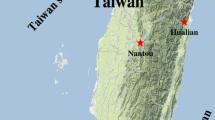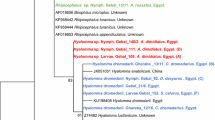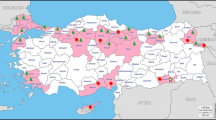Abstract
We supply information about hosts and distribution of Amblyomma dubitatum. In addition, we carry out an analysis of genetic divergence among specimens of A. dubitatum from different localities and with respect to other Neotropical Amblyomma species, using sequences of 16S rDNA gene. Although specimens of A. dubitatum were collected on several mammal species as cattle horse, Tapirus terrestris, Mazama gouazoubira, Tayassu pecari, Sus scrofa, Cerdocyon thous, Myocastor coypus, Allouata caraya, Glossophaga soricina and man, most records of immature and adult stages of A. dubitatum were made on Hydrochoerus hydrochaeris, making this rodent the principal host for all parasitic stages of this ticks. Cricetidae rodents (Lundomys molitor, Scapteromys tumidus), opossums (Didelphis albiventris) and vizcacha (Lagostomus maximus) also were recorded as hosts for immature stages. All findings of A. dubitatum correspond to localities of Argentina, Brazil, Paraguay and Uruguay, and they were concentrated in the Biogeographical provinces of Pampa, Chaco, Cerrado, Brazilian Atlantic Forest, Parana Forest and Araucaria angustifolia Forest. The distribution of A. dubitatum is narrower than that of its principal host, therefore environmental variables rather than hosts determine the distributional ranges of this tick. The intraspecific genetic divergence among 16S rDNA sequences of A. dubitatum ticks collected in different localities from Argentina, Brazil and Uruguay was in all cases lower than 0.8%, whereas the differences with the remaining Amblyomma species included in the analysis were always bigger than 6.8%. Thus, the taxonomic status of A. dubitatum along its distribution appears to be certain at the specific level.

Similar content being viewed by others
References
Almeida ATS, Daemon E, Faccini JLH (2001) Life cycle of female ticks of Amblyomma cooperi Nuttall & Warburton, 1908 (Acari: Ixodidae) under laboratory conditions. Arq Bras Med Vet Zootec 53:316–320
Alvarez MR, Martinez RA (2006) Familias Hydrochoeridae, Agoutidae, Dasyproctidae. In: Barquez RM, Díaz MM, Ojeda RA (eds) Mamíferos de Argentina: sistemática y distribución, Sociedad Argentina para el Estudio de los Mamíferos (SAREM), Tucumán (Argentina), pp. 210–212
Amorim M, Pedro MVJ, Teixeira RHF, Gazeta GS, Serra Freire NM (2003) Ixodofauna de mamíferos na região de Bonito, Mato Grosso do Sul, Brasil. Res. 18° Congr. Bras. Parasitol., Rio de Janeiro, Brasil, p. 104
Aragão HB (1908) Algunas novas especies de carrapatos brazileiros. Braz Med 22:111–115
Aragão HB (1911) Notas sobre ixódidas brazileiros. Mem Inst Oswaldo Cruz 3:145–195
Aragão HB (1918) Notas ixodológicas. Rev Mus Paulista 10:375–417
Aragão HB (1936) Ixodidas brasileiros e de algunos paízes limitrophes. Mem Inst Oswaldo Cruz 31:759–843
Arzua M, Onofrio VC, Barros-Battesti DM (2005) Catalogue of the tick collection (Acari, Ixodida) of the Museu de História Natural Capao da Imbuia, Curitiba, Paraná, Brazil. Rev Bras Zool 22:623–632
Barker RW, Kocan AA, Ewing SA, Wettemann RP, Payton ME (2004) Occurrence of the gulf coast tick (Acari: Ixodidae) on wild and domestic mammals in north-central Oklahoma. J Med Entomol 41:170–178
Barros SLJ, Famadas KM, Lopes LMS, Serra Freire NM (1998) Revisão sobre parasitismo de Mammalia: Chiroptera por Acari: Ixodidae com registro de Amblyomma cooperi Nuttall & Warburton, 1907 em Phyllostomidae no Brasil. Entomol Vect 5:123–136
Barros-Battesti DM, Arzua M, Bechara GH (2006) Carrapatos de importancia médico-veterinaria da regiao Neotropical: um guia ilustrado para identificação de espécies. Vox/ICTTD-3/Butantan, São Paulo
Boero JJ (1945) Los ixodideos de la República Argentina. Rev Med Vet (Buenos Aires) 26:1–10
Camicas JL, Hervy JP, Adam F, Morel PC (1998) Les tiques du monde: nomenclature, stades décrits, hôtes, répartition (Acarida, Ixodida). ORSTOM, Paris
Cumming GS (2002) Comparing climate and vegetation as limiting factors for species ranges of African ticks. Ecology 83:255–268
da Fonseca F, Aragão H (1952) Notas de ixodologia. IV. Considerações sobra a nomenclatura do genero Amblyomma do Brasil e países limítrofes. (Acari: Ixodidae). Mem Inst Oswaldo Cruz 50:729–731
de Souza CE, Calic SB, Camargo MCGO (2004) O papel de capivaras Hydrochaeris hydrochaeris na cadeia epidemiológica da febre maculosa brasileira. Rev Bras Parasitol Vet 13(1):203–205
De Souza SSAL, de Souza CE, Rodrigues Neto EJ, do Prado AP (2006) Dinamica sazonal de carrapatos (Acari: Ixodidae) na mata ciliar de uma área endemica para febre maculosa na região de Campinas, Sao Paulo, Brasil. Cienc Rur 36:887–891
Estrada Peña A (2001) Forecasting habitat suitability for ticks and prevention of tick-borne diseases. Vet Parasitol 31:1–22
Estrada Peña A, Venzal JM, Guglielmone AA (2002) Amblyomma dubitatum Neumann: description of nymph and redescription of adults, together with the description of the immature stages of A. triste Koch. Acarologia 42:323–333
Estrada DA, Schumaker TTS, Souza CE, Neto EJR, Linhares AX (2006) Detecção de riquétsias em carrapatos do gênero Amblyomma (Acari: Ixodidae) coletados em parque urbano do município de Campinas, SP. Rev Soc Bras Med Trop 39:68–71
Estrada-Peña A, Guglielmone AA, Mangold AJ (2004) The distribution and ecological “preferences” of the tick Amblyomma cajennense (Acari: Ixodidae), an ectoparasite of humans and other mammals in the Americas. Ann Trop Med Parasitol 98:283–292
Estrada-Peña A, Venzal JM, Mangold AJ, Cafrune MM, Guglielmone AA (2005) The Amblyomma maculatum Koch, 1844 (Acari: Ixodidae: Amblyomminae) tick group: diagnostic characters, description of the larva of A. parvitarsum Neumann, 1901, 16S rDNA sequences, distribution and hosts. Syst Parasitol 60:99–112
Evans DE, Martins JR, Guglielmone AA (2000) A review of the ticks (Acari, Ixodida) of Brazil, their hosts and geographical distribution—1. The state of Rio Grande do Sul, southern Brazil. Mem Inst Oswaldo Cruz 95:453–470
Famadas K, Lemos ERS, Coura JR, Machado RD, Serra Freire NM (1997) Amblyomma cooperi (Acari: Ixodidae) parasitando humano em área de foco de febre maculosa, São Paulo—Brasil. Acta Parasitol Port 4:154
Freire JJ (1972) Revisão das espécies da familia Ixodidae. Rev Med Vet (Sao Paulo). 8:1–16
Guedes E, Leite RC, Prata MCA, Pacheco RC, Walker DH, Labruna MB (2005) Detection of Rickettsia rickettsii in the tick Amblyomma cajennense in a new Brazilian spotted fever-endemic area in the state of Minas Gerais. Mem Inst Oswaldo Cruz 100:841–845
Guglielmone AA, Nava S (2006) Las garrapatas argentinas del género Amblyomma (Acari: Ixodidae): distribución y hospedadores. Rev Inv Agro (RIA) 35:135–155
Guglielmone AA, Viñabal AE (1994) Claves morfológicas dicotómicas e información ecológica para la identificación de garrapatas del género Amblyomma Koch, 1844 de la Argentina. Rev Inv Agro (RIA) 25:39–67
Guglielmone AA, Mangold AJ, Boero C, Piccinini A, Keirans JE (2002) Hallazgo de Amblyomma cooperi Nuttall & Warburton, 1907 en bovinos de Corrientes, Argentina. Vet Arg 19:124–125
Guglielmone AA, Estrada Peña A, Keirans JE, Robbins RG (2003a) Ticks (Acari: Ixodida) of the neotropical zoogeographic region. Houten, Atalanta
Guglielmone AA, Estrada-Peña A, Mangold AJ, Barros-Battesti DM, Labruna MB, Martins JR, Venzal JM, Arzua M, Keirans JE (2003b) Amblyomma aureolatum (Pallas, 1772) and Amblyomma ovale Koch, 1844 (Acari: Ixodidae): DNA sequences, hosts and distribution. Vet Parasitol 113:273–288
Guglielmone AA, Beati L, Barros-Battesti DM, Labruna MB, Nava S, Venzal JM, Mangold AJ, Szabó MJP, Martins JR, González Acuña D, Estrada-Peña A (2006) Ticks (Ixodidae) on humans in South America. Exp Appl Acarol 40:83–100
Hall TA (1999) BioEdit: a user friendly biological sequence alignment editor and analysis program for Windows 95/98/NT. Nucleic Acid Symp Ser 41:95–98
Horta MC, Labruna MB, Pinter A, Linardi PM, Schumaker TTS (2007) Rickettsia infection in five areas of the state of Sao Paulo, Brazil. Mem Inst Oswaldo Cruz 102:793–801
Ivancovich JC, Luciani CA (1992) Las garrapatas de Argentina. Asociación Argentina de Parasitología Veterinaria, Buenos Aires
Joan T (1930) El amblyomma (sic) de Cooper y demás garrapatas de los carpinchos. 5ª Reun. Soc. Arg. Pat. Reg. Norte, octubre 1929, Jujuy, Argentina 2:1168–1179
Jones EK, Clifford CM, Keirans JE, Kohls GM (1972) The ticks of Venezuela (Acarina: Ixodoidea) with a key to the species of Amblyomma in the Western Hemisphere. Brigh Young Univ Sci Bull Biol Ser 17:1–40
Keirans JE, Brewster BE (1981) The Nuttall and British Museum (Natural History) tick collections: lectotype designations for ticks (Acarina: Ixodoidea) described by Nuttall, Warburton, Cooper and Robinson. Bull Br Mus Nat Hist 41:153–178
Klompen JSH, WC BlackIV, Keirans JE, Oliver JH (1996) Evolution of ticks. Annu Rev Entomol 41:141–161
Labruna MB, Souza SIP (1999) Levantamento de fauna ixodológica através de armadilha de dióxido de carbono, em um parque ecológico no estado de São Paulo. An. XI Sem. Bras. Parasitol. Vet. Salvador, Bahia, Brasil, p. 87
Labruna MB, de Paula CT, Lima TF, Sana DA (2002) Ticks (Acari:Ixodidae) on wild animals from the porto-primavera hydroelectric power station area, Brazil. Mem Inst Oswaldo Cruz 97:1133–1136
Labruna MB, Whitworth T, Horta MC, Bouyer DH, McBride J, Pinter A, Popov V, Gennari SM, Walker DH (2004a) Rickettsia species infecting Amblyomma cooperi ticks from an area in the state of Sao Paulo, Brazil, where Brazilian spotted fever is endemic. J Clin Microbiol 42:90–98
Labruna MB, Pinter A, Teixeira RHF (2004b) Life cycle of Amblyomma cooperi (Acari: Ixodidae) using capybaras (Hydrochaeris hydrochaeris) as hosts. Exp Appl Acarol 32:79–88
Labruna MB, Jorge RSP, Sana DA, Jácomo ATA, Kashivakura CK, Furtado MM, Ferro C, Perez SA, Silveira L, Santos TS, Marques SR, Morato RG, Nava A, Adania CH, Teixeira RHF, Gomes AAB, Conforti VA, Azevedo FCC, Prada CS, Silva JCR, Batista AF, Marvulo MFV, Morato RLG, Alho CJR, Pinter A, Ferreira PM, Ferreira F, Barros-Battesti DM (2005) Ticks (Acari: Ixodida) on wild carnivores in Brazil. Exp Appl Acarol 36:149–163
Labruna MB, Pacheco RC, Ataliba AC, Szabó MJP (2007) Human parasitism by the capibara tick, Amblyomma dubitatum (Acari: Ixodida). Entomol News 118:77–80
Labruna MB, Onofrio VC, Beati L, Arzua M, Bertola PB, Ribeiro AF, Barros-Battesti DM (2009) Redescription of the female, description of the male, and several new records of Amblyomma parkeri (Acari: Ixodidae), a South America tick species. Exp Appl Acarol 49:243–260
Lemos ERS, Machado RD, Coura JR, Guimaraes MAA, Serra Freire NM, Amorim A, Gazeta GS (1997) Epidemiological aspects of the Brazilian spotted fever: seasonal activity of ticks collected in an endemic area in Sao Paulo, Brazil. Rev Soc Bras Med Trop 30:181–185
Mangold AJ, Bargues MD, Mas-Coma S (1998) Mitochondrial 16S rRNA sequences and phylogenetic relationships of Rhipicephalus and other tick genera among Metastriata (Acari: Ixodidae). Parasitol Res 84:478–484
Martins TF, Dantas-Torres F, Nieri-Bastos FA, Marcili A, de Siqueira DB, Aléssio F, da Silva JCR, Labruna MB (2009) Host records for the immature stages of Amblyomma fuscum (Acari: Ixodidae), a rare South American tick species. Entomol News (in press)
Mastropaolo M, Aprile G, Solis G, Beldomenico PM, Peralta JL, Guglielmone AA (2004) Primer registro de Amblyomma dubitatum Neumann 1899 (Acari: Ixodidae) en la provincia de Misiones (Argentina). Revista FAVE 3:67–70
Monteiro CMO, Santos-Rosa L, Dabés L, Rodrigues AFSF (2004) Levantamento preliminar da ixodofauna da mata do Morro do Imperador Juiz de Fora-MG, Brasil. Rev Bras Parasitol Vet 13(1):315
Morrone JJ (2006) Biogeographic areas and transition zones of Latin American and the Caribbean Islands based on the panbiogeographic and cladistic analyses of the entomofauna. Annu Rev Entomol 51:467–494
Nava S, Mangold AJ, Guglielmone AA (2006) The natural hosts of larvae and nymphs of Amblyomma tigrinum Koch, 1844 (Acari: Ixodidae). Vet Parasitol 140:124–132
Nava S, Lareschi M, Rebollo C, Benítez Usher C, Beati L, Robbins RG, Durden LA, Mangold AJ, Guglielmone AA (2007) The ticks (Acari: Ixodida: Argasidae, Ixodidae) of Paraguay. Ann Trop Med Parasitol 101:255–270
Nava S, Mangold AJ, Guglielmone AA (2008a) Aspects of the life cycle of Amblyomma parvum (Acari: Ixodidae) under natural conditions. Vet Parasitol 156:270–276
Nava S, Szabó MPJ, Mangold AJ, Guglielmone AA (2008b) Distribution, hosts, 16S rDNA sequences and phylogenetic position of the Neotropical tick Amblyomma parvum (Acari: Ixodidae). Ann Trop Med Parasitol 102:409–425
Nava S, Guglielmone AA, Mangold AJ (2009a) An overview of systematics and evolution of ticks. Front Biosci 14:2857–2877
Nava S, Estrada-Peña A, Mangold AJ, Guglielmone AA (2009b) Ecology of Amblyomma neumanni (Acari: Ixodidae). Act Trop 111:226–236
Oliveira KA, Oliveira LS CCA, Dias SilvaA, Almeida MR, Almada G, Bouyer DH, Galvao MAM, Mafra CL (2008) Molecular identification of Rickettsia felis in ticks and fleas from an endemic area for Brazilian spotted fever. Mem Inst Oswaldo Cruz 103:191–194
Oscherov EB, Bar ME, Milano AMF, Damborsky MP (2006) Presencia de garrapatas del género Amblyomma (Ixodidae) en áreas naturales protegidas. Acta Bioquím Clín Latinoam 3:185
Pacheco RC, Pinter A, Ferreira PM, Ferreira M, Labruna MB (2004) Carrapatos infestando capivaras em cinco áreas do Estado de Sao Paulo. Rev Bras Parasitol Vet 13(1):315
Pacheco RC, Horta MC, Moraes-Filho J, Ataliba AC, Pinter A, Labruna MB (2007) Rickettsial infection in capybaras (Hydrochoerus hydrochaeris) from Sao Paulo, Brazil: serological evidence for infection by Rickettsia belli and Rickettsia parkeri. Biomédica 27:364–371
Rohr CJ (1909) Estudos sobre ixódidas do Brasil. Gómes Irmao, Rio de Janeiro
Santos Dias JAT (1958) Notes on various ticks (Acarina-Ixodoidea) in collection at some entomological institutes in Paris and London. An Inst Med Trop 15:459–563
Sarmiento NF, Santa Cruz ACM, Comolli JA, Cayo D, Roux JP (2006) Aspectos morfológicos de Amblyomma cooperi Nuttal y Warburton 1908 (Arthropoda: Ixodidae) aislados de Hydrochaeris hydrochaeris en un criadero de Santo Tome (Corrientes). 1a Jornada Nacional de Ectoparasitología Veterinaria. Corrientes, Argentina, p 38
Sinkoc AL, Brum JGW, Muller G, Begrow A, Paulsen RMM (1997) Ocorrencia de Ixodidae parasitos de capivara (Hydrochoerus hydrochaeris Linnaeus, 1776) na Estaçao Ecológica do Taim, Rio Grande-RD, Brasil. Cienc Rur 27:119–122
Sinkoc AL, Brum JGW, Moraes W, Crawshaw P (1998) Ixodidae parasitos de animais silvestres na regiao de Foz de Iguaçú, Brasil e Argentina. Arq Inst Biol 65:29–33
Souza CE, Moraes-Filho J, Ogrezewalska M, Uchoa FC, Horta MC, Souza SSL, Borba RCM, Labruna MB (2009) Experimental infection of capybaras Hydrochoerus hydrochaeris by Rickettsia rickettsii and evaluation of the transmission of the infection to ticks Amblyomma cajennense. Vet Parasitol 161:116–121
Squire FA (1972) Entomological problems in Bolivia. PANS 18:249–268
Szabó MPJ, Castro MB, Ramos HGC, Garcia MV, Castagnolli KC, Pinter A, Veronez VA, Magalhães GM, Duarte JMB, Labruna MB (2007) Species diversity and seasonality of free-living ticks (Acari: Ixodidae) in the natural habitat of wild marsh deer (Blastocerus dichotomus) in Southeastern Brazil. Vet Parasitol 143:147–154
Tamura K, Dudley J, Nei M, Kumar S (2007) MEGA 4: molecular evolutionary genetics analysis (MEGA) software version 4.0. Mol Biol Evol 24:1596–1599
Thompson JD, Higgins D, Gibson TJ (1994) CLUSTAL W: improving the sensitivity of progressive multiple sequence alignment through sequence weighting, position-specific gap penalities and weight matrix choice. Nucl Acids Res 22:4673–4680
van der Heijden KM, Szabó MPJ, Matushima ER, Leite da Veiga M, Santos AA, Egami MI (2003) Valores hematológicos e identificação morfo-citoquímica de células sangüíneas de capivaras (Hydrochoerus hydrochoeris) parasitadas por carrapatos e capivaras livres de infestação. Acta Scientiarum. Anim Sci 25:43–150
Venzal JM, Félix ML, Olmos A, Mangold AJ, Guglielmone AA (2005) A collection of ticks (Ixodidae) from wild birds in Uruguay. Exp Appl Acarol 36:325–331
Venzal JM, Estrada-Peña A, Castro O, de Souza CG, Félix ML, Nava S, Guglielmone AA (2008) Amblyomma triste Koch, 1844 (Acari: Ixodidae): hosts and seasonality of the vector of Rickettsia parkeri in Uruguay. Vet Parasitol 155:104–109
Vogelsang EG, Cordero EH (1940) Las garrapatas (Ixodidae) de Venezuela. Rev Med Vet Parasitol 2:71–76
Woods CA, Kilpatrick CW (2005) Infraorder Hystricognathi Brandt, 1855. In: Wilson DE, Reeder DM (eds) Mammal species of the world: a taxonomic and geographic reference, 3rd edn. The Johns Hopkins University Press, Baltimore, pp 1538–1600
Zerpa C, Venzal JM, López N, Mangold AJ, Guglielmone AA (2003) Garrapatas de Catamarca y Tucumán: estudio de una colección de hospedadores silvestres y domésticos. Revista FAVE 2:167–171
Acknowledgments
We are grateful to INTA and Asociación Cooperadora INTA Rafaela for the financial support to SN, MM, AJM and AAG. We acknowledge the collaboration of P.M. Beldomenico and G. Aprile for sending tick samples.
Author information
Authors and Affiliations
Corresponding author
Rights and permissions
About this article
Cite this article
Nava, S., Venzal, J.M., Labruna, M.B. et al. Hosts, distribution and genetic divergence (16S rDNA) of Amblyomma dubitatum (Acari: Ixodidae). Exp Appl Acarol 51, 335–351 (2010). https://doi.org/10.1007/s10493-009-9331-6
Received:
Accepted:
Published:
Issue Date:
DOI: https://doi.org/10.1007/s10493-009-9331-6




